Developed by W.K. Adams
Students explore the physics of sound, how the ear hears and how musical instruments work through several interactive demonstrations and student activities.
Science Topics
Sound
Vibrations
Resonance
Frequency
Anatomy of the ear
Conservation of energy
Process Skills
Observing
Predicting
Making models
Scientific inquiry
Comparing
Communicating
Grade Level
3-12
Preparation
1 hour *
Set-Up
5 minutes
Activity
40-50 minutes **
Clean-Up
5 minutes
*You can watch a video of the Sound and Music activity here (password protected).
**If you use the optional worksheet, you may need to add an extra 10 minutes for the activity.
Learning Goals
Students will be able to:
- Describe and identify the source of sound – vibrations
- Identify the difference between the directions of a wave and the direction the medium moves
- Explain that sound carries energy and identify how sound energy transfers
- Explain resonant or natural frequency
- Relate the terms pitch, frequency, and high/low sounds
- Demonstrate the path that sound vibrations follow through the ear
- Describe how ears can be permanently damaged by loud sounds.
Materials in Kit
Cup instrument
Tuning fork set
4 posters
150 pipe cleaners
Ping Pong balls with string
Straws that slide together
Materials not in Kit
Scissors – 1 per group
3 long uncooked pasta noodles
3 raisins or small marshmallows
Optional Materials
Rubber mallets
Instructor computer
Assistant
Worksheet
If no computers are available, you can skip sections requiring one.
With more than 15 students, it’s helpful to have an assistant to distribute and collect materials.
The worksheet can be a written log if you want one, however all our testing has been successful without it.
Advanced Preparation and Set-Up
Review the Explanation section and the video examples. You can also watch the full lesson video if you would like to see the Sound and Music lesson in action.
Gather materials and arrange them so they can be easily distributed to students during class
Introduce the Activity
Students will assemble into groups of two or three and sit quietly listening to the sounds around them. Then, they should share one or two sound they heard with their group.
Tell the class that even though all these sounds seem very different, all sounds are caused by the same thing. Explain that they will be sound detective for the day to try and found out what causes sound.
Doing the Activity
What is Sound?
All of this information can be found in the accompanying Sound and Music PowerPoint or PDF slides. The slides can be used for the teacher’s view only or can be shown to the class. The PowerPoint is animated so that the answers do not appear on the screen until the teachers pressed the arrow or return keys.
1. Tell the students they will make a sound using the tuning fork and the tuning forks always make the same clear sound. Show students that you are holding the rounded handle and the two “tines” make a narrow “U”. Show them how to strike the fork properly. If struck on a hard surface the fork could be damaged, changing the frequency.
WARNING: Tuning forks should NOT be struck against hard surfaces like desks. A mallet is ideal, but the heel of your tennis shoe, your kneecaps, your palm, or a textbook are good substitutes.
If you do not have tuning forks, check out this video: https://www.youtube.com/watch?v=vNuDxc9tZMk
2. Have students strike the tuning fork and:
- listen to the fork
- look very closely at the fork while it’s making a sound
Ask the class what they observed.
3. Have the students touch the fork when it is making a sound
WARNING: Don’t touch the tuning fork to your glasses or teeth – they can chip. Try eyelashes, lips (not teeth), bridge of your nose, tip of your nose, ear lobes, fingers, etc. instead.
4. Ask the class:
- What do you feel when it’s making a sound?
- When the fork is making a sound, how can you make it stop?
- What do you feel if it’s silent?
Sympathetic Vibration
1. Set the handle end of your tuning fork (not the tines!) on the table top and ask the class:
- What happens when I do this? Why?
Tell the class that this is called sympathetic vibration, and explain what is happening.
NOTE: this is different than resonance.
Ping Pong Balls – see video
1. Give each group a ping-pong ball with attached string.
2. One student will hold the string so the ping-pong ball hangs down and another will gently touch the quite (not vibrating) tuning fork to the ping-pong ball.
- What do they observe?
3. Repeat step 2, but this time, tough a vibrating tuning fork to the ping-pong ball.
- What happens this time?
- Why do they think this happened?
Your Ear – see video
Show the large anatomy of the ear poster and ask if any of the students have learned about the ear before. Let students offer ideas for a minute or so to get them thinking about the ear.
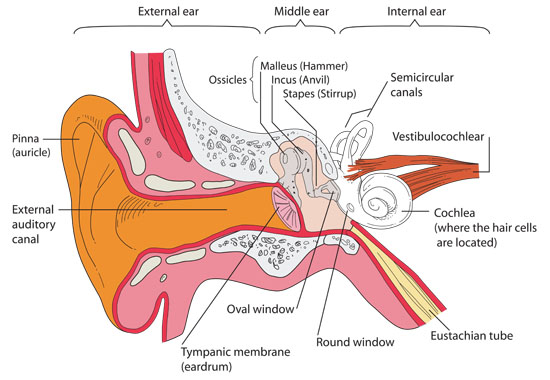
How we hear
1. Ask the class what the outside of the ear is called: the pinna or auricle
→ Explain how sound vibrations are funneled into the ear by the pinna and then travel along the ear canal into the ear.
2. Point to the eardrum and ask what the pink part at the end of the ear canal is called.
→ Repeat again that vibrations are funneled into the ear canal by the pinna, travel along the canal into the ear drum and make the eardrum vibrate.
3. Ask the class what the three tiny bones are called: the ossicles made up of the malleus, the incus, and the stapes.
→ Repeat the route through the ear again, explain now how the eardrum vibrations then make the ossicle each vibrate one at a time. The eardrum vibrations make the malleus vibrate because it is attached to the eardrum. The malleus is attached to the incus, so it makes the incus vibrate and then the incus is attached to the stapes which vibrates. Finally, the stapes sends the vibrations into the snail shaped thing (point to the cochlea).
4. Ask the class what they think the snail shaped thing is called: the cochlea
→ The vibrations continue through the three tiny bones in your middle ear (the ossicles) to the cochlea. The cochlea is filled with thousands of tiny sensors like this: (hold up the hair cell picture next to the ear anatomy poster)
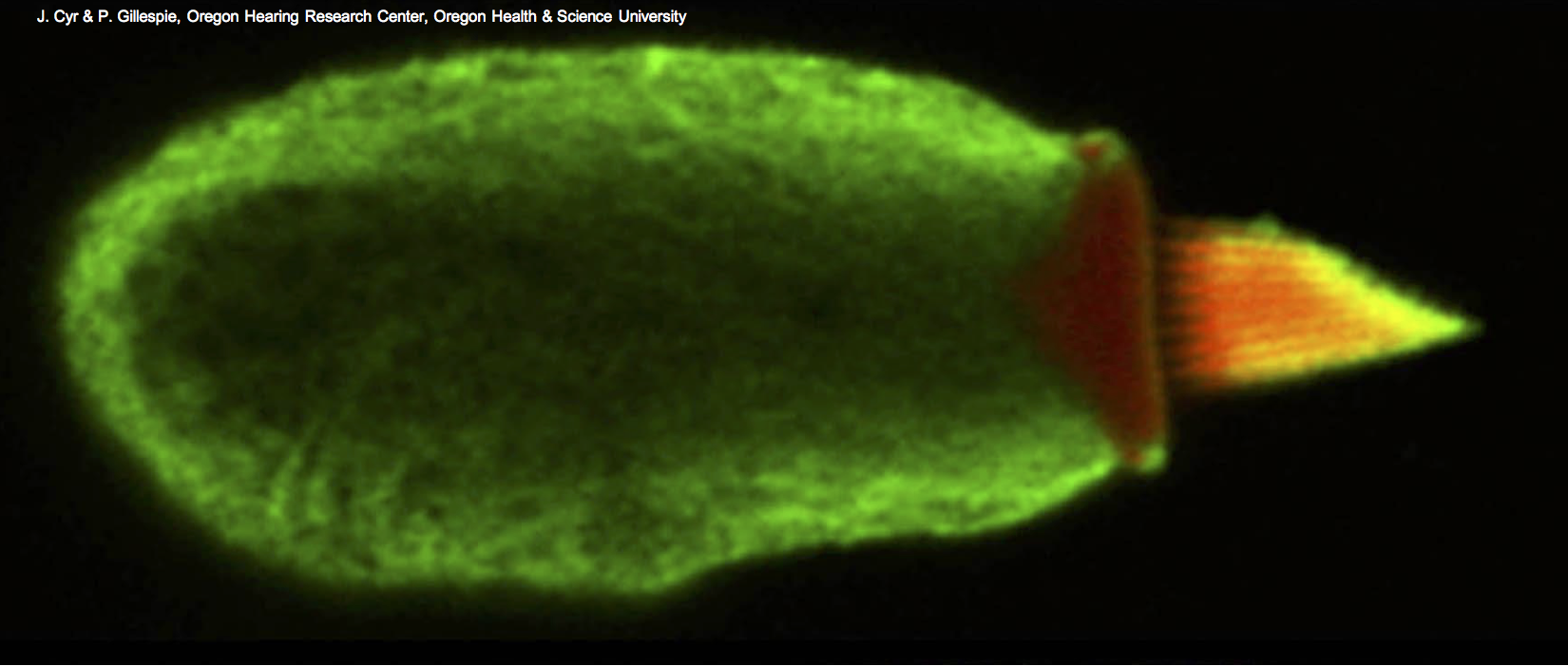
5. Ask the class what the hair cell poster looks like to them.
NOTE: It’s fun to ask the students to tell you what they think the hair cell looks like. You might “candle” or other suggestions. Our favorite is “flaming pickle!”
6. Then ask them if they know what it is called.
→ Tell the class it is a tiny sensor called a hair cell and that the cochlea is filled with them. The green part is the cell body and the yellow part is the hair bundle.
7. Then ask them if they know what it is called.
→ Tell the class it is a tiny sensor called a hair cell and that the cochlea is filled with them. The green part is the cell body and the yellow part is the hair bundle.
8. Hold up the healthy hair bundle poster.
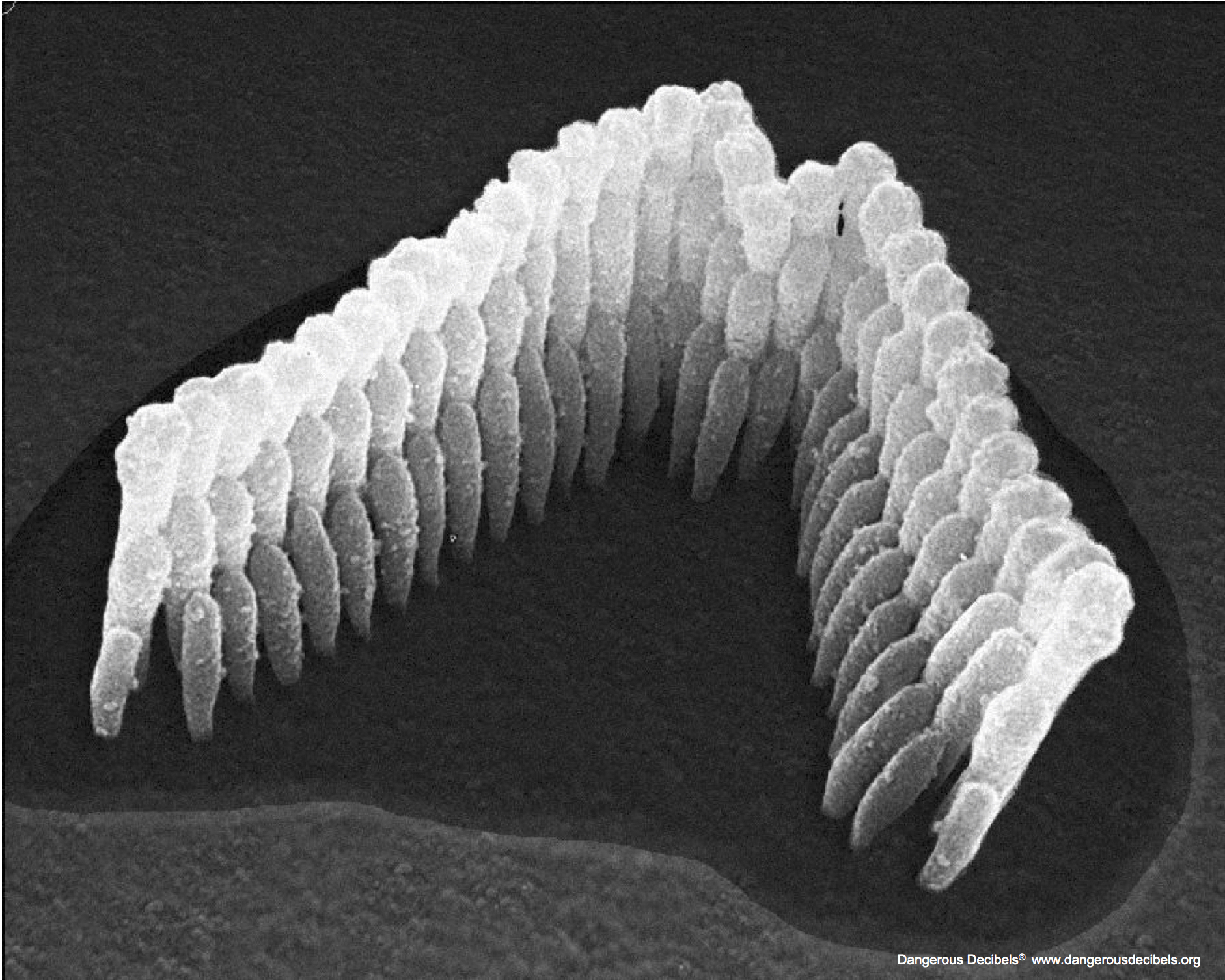
→ Tell them this is what a healthy hair bundle looks like (the yellow part of the pickle). See how the hairs are standing straight up? But when you listen to loud sounds, you can actually damage them. It’s the hair bundle at the top that can be damaged when you listen to loud music or are around loud sounds for too long.
9. Show them the damaged hair bundle poster.
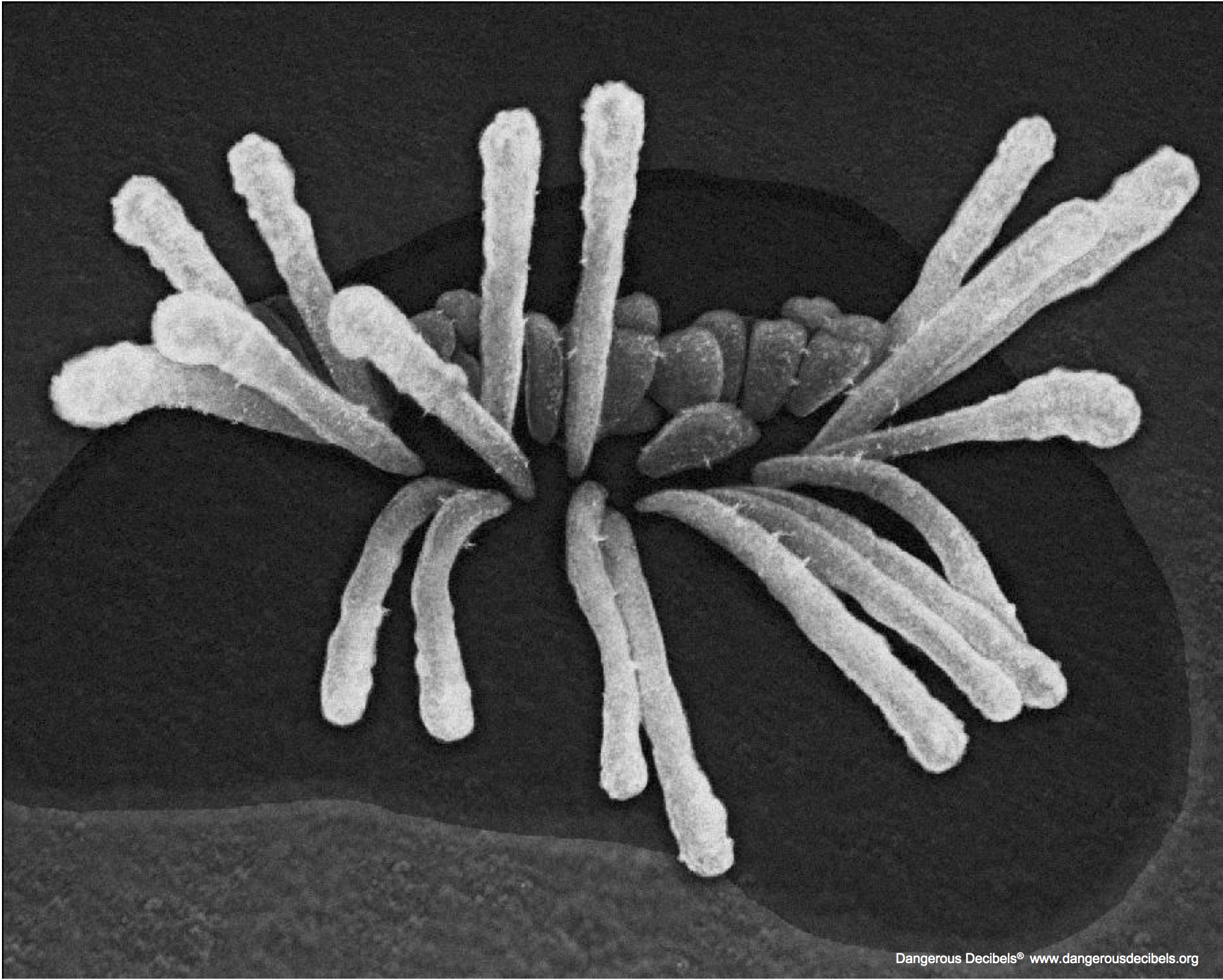
→ Explain that they are damaged hair cells. Point out how some of them are laying down and others are broken off.
10. Ask them: What could have caused this?
→ The loud sounds have bent and broken them.
Build a Model – see video and “Bend it Break it” lesson
1. Ask the class if anyone has ever build a model before. You should get all sorts of offers: model car, model of the solar system etc. Tell them “good, you know what a model is.”
2. Explain that the class is going to make a model.
3. Pass out about 5 pipe cleaners to each student and instruct them not to bend or mess with them yet!
4. Students will make a fist and hold it out.
→ Their fist represents the green (pickle) part of the hair cell, called the body.)
5. Students will then place their pipe cleaner is their fist.
→ The pipe cleaners are the hair bundle.
6. Ask the students if they have any guesses for what their arm is.
→ The arm is the nerve taking the signal from the hair cells to the brain!
7. Now tell the following story to the class:
“You’re sitting at the table talking to your parents.”
Demonstrate how to gently brush their hands back and forth over the pipe cleaners as your dad talks to you in a normal conversational voice.
“Dad says we’re going to the fireworks show today. We get to sit in the (insert your stadium name here) stadium – the best seats there are! But if you want to go, you have to mow the lawn first.”
Ask: Do you think a lawn mower is kind of loud?
→ After students guess, tell them a typical push mower is actually a safe sound for up to two hours.
Ask: Is your yard save?
→ It depends on how big your yard is!
“So we’re going to go out to the yard and start the mower. It’s going to get a little louder.”
Brush the hair cells a little harder (not too hard so that they bend).
“Now we get to go to the (insert local name here) stadium.”
Ask: How loud are fireworks if you get really, really close?
“We’re pretty excited and then they start! Boom! Bang! Boom!”
Now have the students hit their hair bundles hard as their hands go past.
8. Ask the students what the hair bundles look like after the loud noise.
9. Ask the students to try and fix them (straighten them back out).
→ This is what happens in our ears. These are nerve cells and we can’t just regrow them. (unless you’re a bird or a frog.)
Back to your Ear
1. Go to the website http://www.noiseaddicts.com/2009/03/can-you-hear-this-hearing-test and play each sounds from 20 Hz to 20,000 Hz.
2. Students will raise their hands when they hear a sound.
NOTE: Students enjoy hearing the high sound and seeing what they are able to hear, and love to see that they can hear high sounds better than their teacher! (or any other adults in the room).
3. Explain that not everyone’s ears are the same; some are more sensitive, so if you can’t hear the 18,000 Hz sound, even when you’re young, it doesn’t have to be from damage. Most adults can’t hear higher than 12-15,000 Hz.
NOTE: use the words “low pitch” and “high pitch”
Your Voices
1. Instruct the students to hold their fingers on the front of their throats and say “Aaaaaah.”
→ Do they notice the vibrations?
2. Now have them make a high-pitched “Aaaaah” and then a low-pitched “Aaaaah”
→ Do the high and low voices feel different?
Straw Instruments – see video
Pass out 1 of the smaller red straw to each student and then give them the following instructions:
1. With scissors, cut off the tip of the straw to a point, like so. (Try to get both sides the same.)
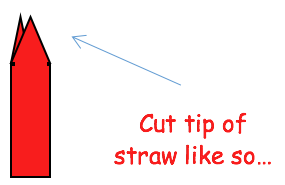
2. Gently chew on the straw to soften the tip, and to get the edges to be smooshed together. The two tips should be almost touching each other.
TIP: Some students will nibble with their front teeth and not get the straw very warm. We’ve seen a few who do this have trouble making sound. Instruct the students to chew with their side teeth and their lips closed. This helps it soften up and work better.
3. Blow really hard into the pointy end. If it’s down correctly (and it might take some practice), a very loud sound will emit from the straw instrument!
4. After the students get their straw instruments working ask them what is vibrating.
→ The tips of the straw are vibrating.
5. Have students gently touch their tongue to the tips of the straw while they make a sound. They will feel it tickling their tongue (and some might find it very annoying!)
6. As a class, discuss the following questions:
→ Does someone across the room hear your straw instrument?
→ Does the air you blow into the straw go in his/her ear for them to hear?
→ If you have bad breath (eat tuna) can the person across the room smell it when they hear you talk? Why is that?
NOTE: Don’t throw away the red straws, we are going to use them again later!
Sound Travels
1. Have the class do the wave! (students stand up and then sit down across the room.)
2. After they do the wave, ask:
→ Did the wave make it across the room?
→ How did you move? Did people who started it move across the room? Name a student or two who were at the beginning of the wave. Ask them if they actually went with the wave across the room. Students will describe that they did not.
→ What did their arms do?
3. Now go to http://www.acs.psu.edu/drussell/Demos/waves-intro/waves-intro.html (also in the slides). Show how the wave travels through air, but the air molecules just move back and forth and then stop.
Straw Instrument – Trombone video
Pass out 1 clear straw to each student and tell them to get their red straws out to build a straw trombone:
1. Fit the uncut end of the red straw into the white straw like so:

2. Once the straws are fitted together, have the class try to make:
→ the lowest pitch (base notes) that they can
→ the highest pitch (treble notes) that you can
3. Tell the students that they can keep their instruments but instruct them to put the instruments away (not just on a desk, they should be out of sight!)
Resonance
Explain the two following terms:
Frequency (rate) – wiggles per second (moves back and forth)
Resonant or natural frequency – the frequency at which an object likes to vibrate
Pasta Demo – see video
Note: This is a demonstration done by the teacher.
1. Place a raisin of a small marshmallow on the end of a piece of pasta.
2. Hold three sticks of pasta in one hand at different lengths.
3. Shake your hand slowly, and the long pasta will swing vigorously back and forth
4. Shake at a medium frequency for the middle pasta to swing vigorously
5. Shake at a high/fast frequency to cause the short pasta to vigorously swing back and forth.
NOTE: Doing any of the three speed fast enough will cause the pasta to snap off.
6. Ask the class: Why does the longer pasta shake more when the hand is moved slowly?
Cup Instrument – see video
Note: This a demonstration done by the teacher.
1. Have a student come up to the front of the room to help you play the cup instrument.
2. Tie the string to a table leg (don’t try to just hold it) and hold the cup so that the string is very tight. Then have the student pluck the string
3. Ask the class what happens.
4. Now re-adjust the string so that it is shorter and have the student pluck it again. Try it at different lengths.
5. Ask the class how the sound changes.
6. Hold the string just before the cup so vibrations can’t travel into the cup and have the student pluck the string again
7. Ask the class what they think the cup is doing to the vibrations.
Review
Review what the class has learned by putting ideas together. Different parts of the cochlea have different resonant frequencies so are sensitive to different pitches. The hairs in the front of the cochlea sense high sounds and the hairs towards the back are sensitive to lower sounds. (This is partly due to the tension of the basilar membrane in different parts of the cochlea.) The hair cells in the front typically get damaged first since they are closer to the sound. This means when you have hearing damage, the is messed up, not just quieter.
→ Sound is caused by vibrations
→ Sound carries energy
→ The vibrations travel through the ear canal, eardrum, ossicles (3 tiny bones) and then into the cochlea
→ Different parts of the cochlea resonate with certain frequencies
some like high pitches
some like low pitches
→ The hair cells sense the sound and send electrical signals to your brain
Explanation
We used Science of Sound, 3rd Ed. by Rossing, Moore and Wheeler as a reference.
Sound is used to describe two different things:
1. An auditory sensation in the ear;
2. The disturbance in a medium that can cause this sensation.
By making this distinction, the age-old question, “if a tree falls in a forest and no one is there to hear it, does it make a sound?” can be answered.
General Lesson Points
Sound waves consist of very small but rapid variations in air pressure (if traveling in air). Here we focus on “vibrations make sound.” It is also true that changing airflow (sirens, speech & singing) and changing heat sources (lightning/thunder) make sound and are not technically vibrations. This is a more advanced idea and might be best to present after a solid and thorough understanding of sound and energy are acquired by students. Presenting it in the beginning could confuse them and these details are not included in most elementary standards.
Sound carries energy. It can make things move.
Build a Model Lesson Points
→ Loud sounds carry more energy than soft sounds.
→ Listening to loud sounds for too long can damage the hair cells, and these can’t be easily fixed.
→ High pitch is a high sound and low pitch are low (bass) sounds.
→ Pitch is how we interpret frequency.
Sound Travels Lesson Points
→ Sound carries energy – it travels through air, but air is not the sound.
→ Air moves back and forth as sound energy goes past.
Sympathetic Vibration Lesson Points
→Some of the energy from the tuning fork is transferred to the table and makes the tabletop vibrate. The tabletop moves a lo t more air than the tuning fork does. The moving air moving is sound so this makes a louder sound. Notice that the tabletop vibrates for a shorter time than the fork alone. Energy is conserved: the tuning fork dissipates less energy (quieter sound) for a longer time. The table dissipates more energy (louder sound) for a shorter time.
→ Sound travels in waves that spread onward from the source to our ears. All things are made up of molecules. The molecules in solids, like metal or wood, are tightly packed together and they can carry sound waves more efficiently than the spread-out molecules in air. Solids are good transmitters of sound. Sound travels through steel 15 times faster than through air. Water’s good too, carrying sound four times faster than air.
Ping Pong Lesson Points
→ Students should note that nothing happens when a quiet fork is touched to a ball. The ball should bounce vigorously away from the vibrating tuning fork. The ball is very light and the fork is vibrating with a fair amount of energy, so it makes the ball move a lot by transferring some of its vibrational energy to the ball when touched.
How We Hear Lesson Points
→ The outside of the ear is called the pinna. It collects the sound and funnels that sound into the ear. Sound waves travel through the air, reach the pinna, and are funneled down to the eardrum.
→ Sound waves hit the eardrum and cause it to vibrate.
→ The three tiny bones are the ossicles: the Malleus, the Incus, and the Stapes (stape-ees). That’s Latin for hammer, anvil, and stirrup. The bones are named for their shapes. The vibrations continue through the tree tiny bones in your middle ear (the ossicles)
Resonance Lesson Points
→ Longer pasta shakes at lower frequencies: lower frequencies have longer wavelengths.
→ Low pitch is a low sound and low pitch has less wiggles per second.
→ Frequency is wiggles per second that the air shakes and pitch is just how we hear and interpret frequency.
Key Lesson Terminology
Pinna – the visible part of the outer ear, also called the auricle- if you can wiggle your ears, the pinna is what you wiggle.
Ossicles – three bones found in the ears of all mammals. These bones are the smallest bones in a person’s body (together, they are about the size of your thumbnail) and they act like a system of levers.
Malleus – also called the hammer. The bone of the middle ear that is attached to the eardrum and the incus (anvil)
Incus – also called the anvil. The bone of the middle ear that is attached to the malleus (hammer) and the stapes (stirrup).
Stapes – also called the stirrup. The tiny both of the middle ear that is connected to a window (the oval window) in the cochlea.
Cochlea – the snail-shaped part of the inner ear which contains the organ of Corti, also known as the organ of hearing.
Hair cell – signals the auditory nerve
Vibrations – a shaking back and forth movement
Pitch – how high or low a tone sounds to a person; how you perceive the frequency of vibrations
Sympathetic vibration – when a vibrating object is put in contact with another material and that if that new material vibrates. This is a transfer of energy and is how an acoustic guitar (not electric) amplifies the sound. The strings cause the body to vibrate and the body moves more are, so it is louder.
Frequency (rate) – wiggles per second (moves back and forth)
Resonant or Natural frequency – the frequency at which an object likes to vibrate – only certain frequencies resonate any given object.
Optional Extensions
There is an activity called “How musical instruments work” that helps students sort out the differences between resonance and sympathetic vibration and their respective roles in musical instruments. This is recommended as a follow up activity to Musical Instruments 1 and 2 in the Science of Music Unit
There is a game on the Dangerous Decibels virtual lab that lets you hear what different sounds would be like if you had hearing damage
What is Sound Extension: Look at other objects that make sounds with highly visible vibrations
Musical instruments: triangles, tambourine, guitar, drum, cymbal
Household items: wind up clock with alarm, kitchen timer, hand bell, wind chimes
Sympathetic Vibration Extension: Students can place a vibrating tuning fork on other surfaces
A chair, the floor, the teacher’s desk, a recess ball, a lunch box, ect.
Ask if they detect any patterns in what made the fork’s sound louder or softer.
If necessary, guide their theorizing by pointing out that some things, like a rubber recess ball, have spaces filled largely with air, while others – the table – are packed quite solid. Ask them if vibrations can more easily through air or a solid.
Sound Travels Extension: You must have a computer for this
Show the students the PhET “Sound” simulator and choose the last tab “Listen with Varying Pressure”
Ask them what happens to the sound when the air is removed from the box.
Cup Instrument Extension: Musical Instruments part 2 (from Science of Music unit) is an entire lesson utilizing the cup instrument and investigates other stringed instruments.
Modifications
It’s important to tell students with modifications what they should be looking for ahead of time so they are more willing to stay engaged with the activity and understand what they’re getting out of the experience.
Hard of hearing students can feel vibrations through speakers by touching them, or by touching the instrument itself. With the straw instrument, they can feel the vibrations on their lips and their tongue.
